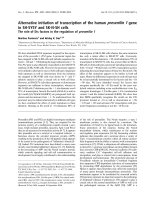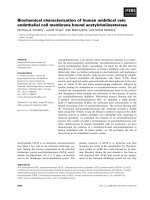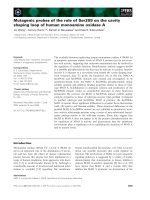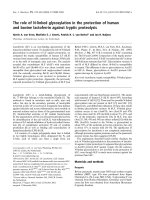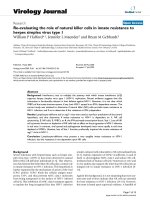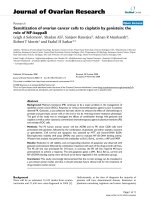The role of human umbilical vein endothelial cells in osteogenic differentiation of dental follicle-derived stem cells in in vitro co-cultures
Bạn đang xem bản rút gọn của tài liệu. Xem và tải ngay bản đầy đủ của tài liệu tại đây (1.84 MB, 11 trang )
Int. J. Med. Sci. 2018, Vol. 15
Ivyspring
International Publisher
1160
International Journal of Medical Sciences
2018; 15(11): 1160-1170. doi: 10.7150/ijms.27318
Research Paper
The Role of Human Umbilical Vein Endothelial Cells in
Osteogenic Differentiation of Dental Follicle-Derived
Stem Cells in In Vitro Co-cultures
Jung-Suk Bok1, Sung-Hoon Byun1, Bong-Wook Park1, Young-Hoon Kang1, Sung-Lim Lee2, Gyu-Jin Rho2,
Sun-Chul Hwang3, Dong Kyun Woo4, Hyeon-Jeong Lee2,, June-Ho Byun1,
1.
2.
3.
4.
Department of Oral and Maxillofacial Surgery, Gyeongsang National University School of Medicine and Gyeongsang National University Hospital,
Institute of Health Sciences, Gyeongsang National University, Jinju, Republic of Korea
Department of Theriogenology and Biotechnology, College of Veterinary Medicine, Gyeongsang National University, Jinju, Republic of Korea
Department of Orthopaedic Surgery, Institute of Health Sciences, Gyeongsang National University School of Medicine, Jinju, Republic of Korea
College of Pharmacy and Research Institute of Pharmaceutical Sciences, Gyeongsang National University, Jinju, Republic of Korea
Corresponding authors: June-Ho Byun (Department of Oral and Maxillofacial Surgery, Gyeongsang National University School of Medicine and Gyeongsang
National University Hospital, Institute of Health Sciences, Gyeongsang National University, Chilam-dong, Jinju, Republic of Korea, Tel: 82-55-750-8258, Fax:
82-55-761-7024, E-mail address: ) or Hyeon-Jeong Lee (Department of Theriogenology and Biotechnology, College of Veterinary Medicine,
Gyeongsang National University, Jinju, Republic of Korea, Tel: 82-55-772-2347, E-mail address: ).
© Ivyspring International Publisher. This is an open access article distributed under the terms of the Creative Commons Attribution (CC BY-NC) license
( See for full terms and conditions.
Received: 2018.05.17; Accepted: 2018.06.30; Published: 2018.07.30
Abstract
Angiogenesis and vascularization are essential for the growth and survival of most tissues. Engineered bone
tissue requires an active blood vessel network for survival and integration with mature host tissue.
Angiogenesis also has an effect on cell growth and differentiation in vitro. However, the effect of angiogenic
factors on osteoprogenitor cell differentiation remains unclear. We studied the effects of human umbilical vein
endothelial cells (HUVECs) on osteogenic differentiation of dental follicle-derived stem cells (DFSCs) in vitro by
co-culturing DFSCs and HUVECs. Cell viability, based on metabolic activity and DNA content, was highest for
co-cultures with a DFSC/HUVEC ratio of 50:50 in a 1:1 mixture of mesenchymal stem cell growth medium and
endothelial cell growth medium. Osteoblastic and angiogenic phenotypes were enhanced in co-cultures with a
DFSC/HUVEC ratio of 50:50 compared with DFSC monocultures. Increased expression of angiogenic
phenotypes and vascular endothelial growth factor (VEGF) levels were observed over time in both 50:50
DFSC/HUVEC co-cultures and DFSC monocultures during culture period. Our results showed that increased
angiogenic activity in DFSC/HUVEC co-cultures may stimulate osteoblast maturation of DFSCs. Therefore, the
secretion of angiogenic factors from HUVECs may play a role in the osteogenic differentiation of DFSCs.
Key words: Dental follicle-derived stem cells; human umbilical vein endothelial cells; co-culture; osteogenic
differentiation
Introduction
Bone is a dynamic tissue with a significant
capacity to re-generate. One major reason for the
self-healing ability of the bone is its high degree of
vascularization. Vascularization is essential for bone
remodeling during normal development, bone
fracture repair, engraftment of autogenous bone, or
bone tissue engineering in vivo. Vascular disruption
due to bone damage leads to the formation of a
hypoxic zone at the injury site. This hypoxic zone is
believed to stimulate angiogenesis to restore blood
flow to the damaged site. In vitro models of cellular
and molecular interactions between blood vessels and
bone cells also show that there are reciprocal
functional interactions between endothelial cells or
endothelial progenitor cells and osteoblast-like cells
during osteogenesis [1-3].
Stem/progenitor cells have recently been
developed as regenerative alternatives to autologous
bone grafting for the treatment of various bone
defects. The mesenchymal stem cells (MSCs) for
cell-based or tissue-engineered regeneration can be
isolated from small biopsy specimens obtained from
outpatients under local anesthesia. These cells can be
expanded in culture and can differentiate into distinct
Int. J. Med. Sci. 2018, Vol. 15
cell lineages under particular conditions. The major
source of MSCs in adults is the bone marrow, where
they exist in the supporting stroma. Bone
marrow-derived MSCs are multipotent and are the
designated gold standard for differentiating into
osteogenic cells capable of forming bones in vitro.
However, the process of isolating MSCs from bone
marrows of patients can be complicated and painful
[4-6].
The dental tissue provides an alternative source
for osteogenic precursor cells. The tooth germ, also
known as the tooth bud, is a primordial structure
from which a tooth is formed. The tooth germ, which
usually disappears upon tooth formation, exists in the
slow-growing third molar of humans until the age of
10 to 16 years. The tooth germ consists of the enamel
organ, the dental papilla, and the dental follicle. The
dental follicle surrounds the tooth germ during the
early stages of tooth development, and plays a crucial
role in tooth eruption and development. Third molar
tooth germs have been extracted from young adults
for various reasons, including orthodontic treatments.
The dental follicle from the extracted tooth germ is an
alternative source of osteogenic cells for cell-based
regenerative medicine. The dental follicle-derived
stem cells (DFSCs) have been shown to differentiate
into active osteoblasts that are involved in the
mineralization of the bone matrix [7-11].
Bone regeneration can be enhanced by
improving angiogenesis, a process regulated by
various angiogenic factors. The combined delivery of
osteogenic and angiogenic factors is more effective at
promoting functional fracture healing compared with
osteogenic factors alone, and is a novel approach in
bone tissue engineering [12-16]. However, the
mechanisms by which angiogenic factors impact
osteoprogenitor cell differentiation are unknown.
Enhanced angiogenesis does not always correlate
with enhanced osteogenesis, and the effects of
angiogenic
factors
on
osteoprogenitor
cell
differentiation remain controversial. Some studies
have shown no difference in the extent of
angiogenesis in fracture nonunions and fracture
unions [17-20].
Human umbilical vein endothelial cells
(HUVECs), a prominent subset of macrovascular
endothelial cells, are commonly used to evaluate the
function and pathology of endothelial cells (e.g.,
angiogenesis). Several studies have reported the
effects of angiogenic factors on osteo/odontogenic
potential of dental stem cells [21-24]. However, the
effects of the HUVECs on osteogenic differentiation of
DFSCs are unknown. Therefore, we studied the role of
HUVECs in osteogenic differentiation by co-culturing
HUVECs with DFSCs.
1161
Materials and Methods
Culture of hDFSCs
Dental follicles were harvested from lower
impacted third molars that were surgically extracted
from patients aged 13 to 15 years after obtaining their
informed consent, as required by the Ethics
Committee of Gyeongsang National University
Hospital. The dental follicles were minced into 1–3
mm2 pieces, and cultured at 37°C in 95% humidified
air and 5% CO2, in 100-mm culture dishes containing
Dulbecco's Modified Eagle's Medium (DMEM)
supplemented with 10% heat-inactivated fetal bovine
serum (FBS), 100 IU/mL penicillin, and 100 μg/mL
streptomycin. Upon reaching 90% confluence,
adherent cells were passaged by gentle trypsinization
and reseeded in fresh medium. The medium was
changed every 3 days during the induction period
and cells at passages 3-5 were used.
Analysis of surface markers
Flow
cytometry
(FACSCalibur,
Becton
Dickinson, CA, USA) was used to detect surface
antigens on DFSCs (1 × 105 cells per marker).
Specifically, cells were analyzed for the presence of
mesenchyme markers (CD44, CD73, CD90, and
CD105) and the absence of the hematopoietic markers
CD34 and CD45, as described previously [25]. DFSCs
that were at approximately 90% confluence were
trypsinized, fixed in 3.7% formaldehyde solution, and
incubated
with
fluorescein
isothiocyanate
(FITC)-conjugated primary antibodies (mouse
anti-human) against CD34 (BD Pharmingen, CA,
USA), CD44 (BD Pharmingen), CD45 (Santa Cruz
Biotechnology, Santa Cruz, CA, USA), and CD90 (BD
Pharmingen). For analysis of CD105 (mouse
monoclonal, Santa Cruz Biotechnology) and CD73
(mouse monoclonal, BD Bioscience, CA, USA)
expression, cells were treated with primary antibodies
for 1 hour at 4°C, washed with Dulbecco's phosphate
buffered saline, and treated with FITC-conjugated
goat anti-mouse immunoglobulin G (IgG) [BD
Pharmingen] for 1 hour at 4°C in the dark. A total of
10,000 labeled cells were acquired and results were
analyzed using BD FACSVerse™ with BD
FACSuite™ software.
DFSCs differentiation into mesenchymal cell
lineages in vitro
DFSCs at passages 3-5 were evaluated for their
ability to differentiate into adipogenic and osteogenic
cell lineages. The cells were cultured in
lineage‐specific media for 21 days and the medium
was changed every 3 days. Osteogenic induction
medium was composed of DMEM, supplemented
Int. J. Med. Sci. 2018, Vol. 15
with 10% FBS, 50 μg/mL L-ascorbic acid 2-phosphate,
10
nM
dexamethasone,
and
10
mM
β-glycerophosphate. Osteogenesis was confirmed by
alizarin red S and von Kossa staining. Adipogenic
medium consisted of 1 μM dexamethasone, 10 μM
insulin, 100 μM indomethacin, and 500 μM
isobutylmethylxanthine. For the detection of lipid
droplets, differentiated cells were stained with oil red
O solution for 30 min.
Culture of HUVECs and immunocytochemical
analysis
HUVECs were purchased from Gibco and
cultured in Medium 200 (Gibco, ON, Canada)
supplemented with low serum growth supplement
(LSGS) (Gibco, ON, Canada) at 37°C, 95% humidified
air, and 5% CO2. The medium was changed every 3
days during the induction period and cells at passages
3-5 were used.
CD31 expression, which indicated the presence
of
endothelial
cells,
was
visualized
via
immunocytochemical staining. The cells at passage 3
were rinsed with phosphate buffered saline (PBS),
fixed with 4% paraformaldehyde for 20 min,
permeabilized with PBS containing 0.1% Triton X-100
for 5 min, and blocked with PBS supplemented with
10% bovine serum albumin for 1 hour. The cells were
first incubated with an antibody against CD31 (1:3200
dilution; Cell Signaling Technology, MA, USA) for 1
hour at room temperature. Cells were then incubated
with FITC-conjugated donkey anti-mouse IgG
secondary antibodies (1:100 dilution; Thermo Fisher
Scientific, MA, USA) for 1 hour at room temperature.
Cell nuclei were stained with 1 μg/ml
4',6-diamidino-2-phenylindole (DAPI), and the cells
were observed using a fluorescence microscope and
camera system (DM 4000B, Leica, Wetzlar, Germany).
Co-culture of DFSCs with HUVECs
DFSCs and HUVECs were co-cultured in 24-well
plates at a density of 1 × 104 cells/well, at five
different DFSC/HUVEC ratios (100:0, 75:25, 50:50,
25:75, and 0:100) in three different types of culture
media: (i) MSC growth medium (MM) containing
DMEM medium supplemented with 10% FBS, 100
IU/ml penicillin, 100 μg/mL streptomycin and 2 mM
GlutaMAX™-I, (ii) endothelial cell growth medium
(EM) containing Medium 200 supplemented with
LSGS, and (iii) 1:1 mixture of MM and EM. The
medium was changed every 2-3 days.
Cell metabolic activity assay
The metabolic activity of co-cultured cells with
DFSCs and HUVECs was determined by the Alamar
Blue-based metabolic assay (Invitrogen, CA, USA),
according to the manufacturer's instructions. After 5
1162
days of co-culturing DFSCs and HUVECs in different
ratios and different types of media (as described
above), 100 μl of Alamar Blue reagent was added to
each well at a final concentration of 10% (v/v) and
incubated for 4 hours at 37°C, 95% humidified air, and
5% CO2. After incubation, 200 μl of the supernatant
from each well was transferred to a 96-well plate for
optimal measurement by a microplate reader. The
absorbance of each sample was measured at 570 nm
by VersaMax™ Microplate Reader (Molecular
Devices, CA, USA). The results of each experimental
group were normalized to the values of the
medium-only internal control group.
DNA quantification assay
Cellular DNA content was measured using
QIAamp® DNA Mini Kit (Qiagen, CA, USA)
according to the manufacturer’s instructions. After 5
days of co-culturing DFSCs and HUVECs in different
ratios and different types of media (as described
above), the cells were trypsinized and the cell pellets
were stored at -80°C until DNA extraction. The
samples were lysed with lysis buffer and proteinase
K. DNA concentration and purity were measured
with an OPTIZEN NANO Q spectrophotometer
(Mecasys, Daejeon, Korea), with an A260/A280 ratio of 2
± 0.2, which indicated a pure preparation.
Effects of HUVECs on osteoblastic phenotypes
of DFSCs in vitro
To examine the effects of HUVECs on
osteoblastic phenotypes of DFSCs in vitro, DFSCs and
HUVECs were co-cultured (DFSC/HUVEC ratio of
1:1) in 24-well plates at a density of 1 × 104 cells/well
in a 1:1 mixture of MM and EM. At 60–70%
confluence, the co-cultured cells were transferred to
osteogenic induction medium and cultured for 21
days. As control, DFSCs were seeded in 24-well plates
at a density of 1 × 104 cells/well in osteogenic
induction medium for 21 days. The activity of alkaline
phosphatase (ALP), an early marker for osteoblast
differentiation, and mineralized nodule formation
(indicative of maturation of the osteoblast phenotype)
were used as indicators of osteoblast differentiation.
ALP activity, alizarin red S and von Kossa staining,
and calcium content were examined using a
previously published method [25, 26].
Quantitative PCR (qPCR) analysis
The expression of the angiogenesis-related
genes, vascular endothelial growth factor (VEGF) and
angiotensin 1 (ANG1), was analyzed by qPCR in
co-cultured cells (DFSC/HUVEC ratio of 1:1) during
osteoblast differentiation in osteogenic induction
medium at 7, 14, and 21 days of culture. Total RNA
Int. J. Med. Sci. 2018, Vol. 15
1163
(500 ng) was used to synthesize complementary DNA
(cDNA) using HiSenScript RH(-) RT PreMix kits
(iNtRON Biotechnology, Seongnam, Korea). The
cDNA reaction mixture (20 μl) was incubated at 42°C
for 1 hour. qPCR was performed using a Rotor-Gene
Q cycler (Qiagen, CA, USA) with 50 ng of cDNA and
quantified with 2× Rotor-Gene SYBR Green Master
Mix (Qiagen) using specific primer sets (Table 1).
Reactions were performed with an initial
denaturation at 95°C for 10 min, followed by 40 cycles
at 95°C for 10 s, 60°C for 6 s, and 72°C for 6 s.
Rotor-Gene Q Series Software (Qiagen) was used to
determine melting curves, amplification curves, and
cycle threshold values. Gene expression levels were
normalized to the corresponding control values of
glyceraldehyde 3-phosphate dehydrogenase. All
samples were run in triplicates and confirmed by 1.5%
agarose gel electrophoresis.
Table 1. Primers used in qPCR
Target
gene
1 VEGF
2 ANG 1
3 GAPDH
Sequence
Product
size (bp)
125
F: AGAGACACATTGTTGGAA
R: GTTTCAATGGTGTGAGGACA
F: TCTTCTCTGCCTGTAAGTGTCC
142
R: GGTATTGCTACCTTGCCAACAA
F: AGTCAGCCGCATCTTCTTTT
189
R: CCAATACGACCAAATCCGTT
Annealing
temperature
60°C
60°C
60°C
Enzyme-linked immunosorbent assay (ELISA)
of VEGF
In co-cultures of DFSCs and HUVECs that were
cultured in osteogenic induction medium, culture
media was collected after 48 houres at 7, 14, and 21
days of culture. VEGF levels were measured using the
human VEGF ELISA Kit (Enzo Life Sciences, NY,
USA).
For
each
sample,
100
μl
of
osteogenic-conditioned
medium
was
assayed
according to the manufacturer's instructions. Optical
density was measured at a wavelength of 450 nm with
a VersaMax™ Microplate Reader (Molecular Devices,
CA, USA), and results were calculated using a
calibration curve.
Statistical analysis
Each experiment was independently performed
at least three times, and results from one experimental
replicate for each case were shown as representative
data. Data were expressed as mean ± standard error of
the mean and statistical analyses were computed
using IBM SPSS 21.0 software. Data were evaluated
using one-way analysis of variance (ANOVA),
Tukey’s multiple comparison test, and the
Mann-Whitney test. Comparisons with P < 0.05 were
considered statistically significant.
Results
Characterization of DFSCS
After passage 3, dental follicle-derived cells
became relatively homogeneous and showed typical
spindle-shaped
morphology
(Fig.
1A).
Immunophenotypic analysis of cell surface antigens
by flow cytometry showed that dental follicle-derived
cells expressed the mesenchymal markers, CD44,
CD73, CD90, and CD105, and were negative for the
expression of hematopoietic stem cell markers, CD34
and CD45 (Fig. 1B). Cytochemical staining of the
dental follicle-derived cells that were cultured in
different induction media showed accumulation of
lipid vacuoles and intracellular lipid droplets, and the
deposition of mineralized extracellular matrix (Fig.
1C). This indicated that the dental follicle-derived
cells successfully differentiated into mesenchymal cell
lineages such as adipocytes and mature osteoblasts.
Our results showed that the dental follicle-derived
cells were phenotypically similar to MSCs, and were
most likely DFSCs.
CD31 expression in HUVECs
HUVECs exhibited the characteristic rounded,
cobblestone-like morphology at passage 3 (Fig. 2A),
Immunocytochemical analysis showed that CD31, an
endothelial marker, was expressed in HUVECs
cultured in Medium 200 supplemented with LSGS
(Fig. 2B).
Optimization of DFSCs/HUVECs co-culture
conditions
To optimize conditions for co-cultures of DFSCs
and
HUVECs,
co-cultures
with
varying
DFSC/HUVEC ratios were grown in different culture
media. Monocultures of DFSCs and HUVECs were
used as controls. Cell metabolic activity and DNA
content were used as output parameters to
quantitatively assess cellular viability in these
different culture conditions.
DFSCs cultured in MM showed increased cell
metabolic activity compared with HUVECs. Higher
cell
metabolic
activity
was
observed
in
DFSC/HUVEC co-cultures, regardless of co-culture
ratios, compared with that in both DFSC and HUVEC
monocultures. We observed no significant difference
in cell metabolic activity between co-cultures with
varying DFSC/HUVEC ratios. DFSCs cultured in EM
also showed increased cell metabolic activity
compared with HUVECs. We observed no significant
difference in cell metabolic activity between
DFSC/HUVEC co-cultures and DFSCs cultured in
EM. Cell metabolic activity was the lowest in DFSC
monocultures and highest in co-cultures with
Int. J. Med. Sci. 2018, Vol. 15
DFSC/HUVEC ratio of 50:50 grown in mixed culture
media of MM and EM. A comparison of cells grown in
different culture media revealed that co-cultures with
1164
a DFSC/HUVEC ratio of 50:50 grown in MM and EM
mixed media showed the highest cell metabolic
activity levels (Fig. 3A and B).
Figure 1. Characterization of DFSCs. A: Differential interference contrast microscope image of DFSCs at passage 3 reveals a spindle-shaped morphology. Scale bar = 250 µm.
B: DFSCs are positive for surface markers present on MSCs. C: Differentiation of DFSCs in vitro. Oil red O staining of lipid droplets indicated adipogenesis. Alizarin red S and von
Kossa staining of mineralized nodules and calcium deposition indicated osteogenesis. Scale bar = 100 µm.
Int. J. Med. Sci. 2018, Vol. 15
1165
Figure 2. Culture of HUVECs. A: Rounded and cobblestone-like morphology of HUVECs at passage 3. Scale bar = 500 µm. B: Fluorescent immunostaining for endothelial
genetic marker CD31 expressed by HUVECs. 40× magnification.
HUVECs showed low levels of cellular DNA
content regardless of culture medium. The DNA
content of co-cultures and DFSC monocultures grown
in MM was significantly higher than that of HUVEC
monocultures. A comparison of co-cultures with
varying DFSC/HUVEC ratios grown in MM showed
low levels of DNA content in 25:75 co-cultures. DFSC
monocultures, 75:25 co-cultures, and 50:50 co-cultures
grown in MM showed similar levels of cellular DNA
content. In cells grown in EM, cellular DNA content
levels were the highest in DFSC monocultures and
50:50 co-cultures. DNA content levels were also the
highest in DFSC monocultures and 50:50 co-cultures
grown in MM and EM mixed media. A comparison of
cells grown in different culture media revealed that
co-cultures with a DFSC/HUVEC ratio of 50:50
grown in MM and EM mixed media showed the
highest levels of DNA content (Fig. 3C and D). These
results showed that optimal cell viability was
achieved in co-cultures with a DFSC/HUVEC ratio of
50:50 grown in 1:1 mixed medium of MM and EM.
Analysis of osteoblastic phenotypes in 50:50
co-culture
Because the optimal co-culture ratio for DFSCs
and HUVECs was shown to be 50:50 when cells were
grown 1:1 MM and EM mixed media, we analyzed the
expression of osteoblastic phenotypes in 50:50
co-cultures by measuring ALP activity, extent of
mineralization, and calcium content levels in these
cells. ALP activity was significantly higher in 50:50
co-cultures than in DFSC monocultures at 7 and 14
days of culture (Fig. 4A). DFSC/HUVEC 50:50
co-cultures also showed increased alizarin red- and
von Kossa- positive mineralization, and calcium
content levels when compared with DFSC
monocultures at 14 and 21 days of culture (Fig. 4B and
C). Our results suggest that osteogenic phenotypes of
DFSCs could be enhanced via co-culture of DFSCs
and HUVECs.
Expression of angiogenesis-related genes in
50:50 co-cultures
We
studied
the
expression
of
angiogenesis-related genes, VEGF and ANG1, in 50:50
co-cultures of DFSCs and HUVECs. qPCR analysis
showed that the expression of VEGF mRNA
significantly increased at 7, 14, and 21 days of culture
in 50:50 co-cultures compared with that in DFSC
monocultures. DFSC/HUVEC 50:50 co-cultures
showed the highest increase in ANG1 mRNA
expression compared with DFSC monocultures at 14
days of culture (Fig 5A).
Int. J. Med. Sci. 2018, Vol. 15
1166
Figure 3. Cell metabolic activity and DNA content in co-cultures with different cell ratios (DFSC/HUVEC ratios of 100:0, 75:25, 50:50, 25:75, or 0:100) grown in different
culture media (MM, EM, and MIX). A and B: Cell metabolic activity. C and D: DNA content. * indicates P < 0.05, ** indicates P < 0.01, and *** indicates P < 0.001. MM: MSCs
growth medium; EM: endothelial cell growth medium; MIX: 1:1 mixture of MM and EM.
Int. J. Med. Sci. 2018, Vol. 15
1167
Figure 4. Osteoblastic phenotypes were enhanced in co-cultures with a DFSC/HUVEC ratio of 50:50. A: Bioactivity of ALP. B and C: Alizarin red- and von Kossa-positive
mineralization and calcium content. Scale bar = 100 µm. ** indicates P < 0.01 and *** indicates P < 0.001.
VEGF protein levels were also significantly
increased in 50:50 co-cultures when compared with
those in DFSC monocultures at 7, 14 and 21 days of
culture (Fig. 5B). Interestingly, we observed that
VEGF and ANG1 mRNA expression, and VEGF
protein levels increased over time in both 50:50
co-cultures and DFSC monocultures during the
three-week experimental period. The time-dependent
increase of angiogenic factors in both DFSC
monocultures and DFSC/HUVEC co-cultures may be
accompanied by osteoblastic maturation of both DFSC
monocultures and 50:50 co-cultures [27]. In addition,
Int. J. Med. Sci. 2018, Vol. 15
1168
Figure 5. Angiogenic phenotypes in DFSC monocultures and co-cultures with a DFSC/HUVEC ratio of 50:50. A: qPCR analysis shows increased expression of
angiogenic-related genes, VEGF and ANG1, in co-cultures with DFSC/HUVEC ratio of 50:50 B: VEGF protein levels showed a higher increase over 21 days in DFSC/HUVEC
50:50 co-cultures compared with those in DFSC monocultures.
our results also suggested that increased secretion of
angiogenic factors in co-cultures of DFSCs and
HUVECs may enhance osteoblastic maturation of
DFSCs.
Discussion
The bone is a complex and highly vascularized
tissue.
Well-developed
microvasculature
and
microcirculation systems are critical for the
homeostasis and regeneration of bone. Physiological
angiogenesis is a highly organized and tightly
regulated process that is influenced by angiogenic and
antiangiogenic factors, including several chemokines,
depending on different tissue requirements. The
disruption of oxygen supply/blood flow due to bone
damage results in the formation of a hypoxic zone at
the injury site that is thought to stimulate
angiogenesis. During angiogenesis, endothelial cells
get activated by angiogenic factors, which results in
their proliferation, migration, and complete
maturation to form new blood vessel networks. These
networks support bone regeneration by delivering
essential substances such as oxygen, nutrients, and
regulatory cytokines. Aberrant angiogenesis might
lead to pathogenesis in the bone tissue [2, 3, 28].
Angiogenesis also influences the self-renewal
and differentiation abilities of stem cells. Cells
exhibiting stem cell-like properties have been isolated
from different parts of the tooth, including the dental
pulp, the apical papilla, and the dental follicle. Dental
stem cells have similar characteristics to bone
marrow-derived mesenchymal stem cells and can
differentiate into osteoblasts and chondrocytes
[29-33]. Dental stem cells can be harvested from donor
tissue with relative ease (e.g. surgical extraction of an
impacted third molar tooth) and, therefore, provide
an
attractive
alternative
to
using
bone
marrow-derived stem cells for bone tissue
engineering. In our study, dental follicle-derived cells
expressed mesenchymal cell markers, such as CD44,
CD73, CD90, and CD105, and were negative for the
expression of hematopoietic stem cell markers, CD34
and CD45. These cells also successfully differentiated
into mesenchymal cell lineages such as adipocytes
and mature osteoblasts. Therefore, they can be
classified as DFSCs.
Although angiogenic factors are important for
the viability and differentiation of MSCs, their precise
effects on the osteogenic differentiation of MSCs
remain unclear [17-20]. HUVECs, which produce
Int. J. Med. Sci. 2018, Vol. 15
several types of angiogenic factors, are the most
commonly used in vitro models to study the
physiological and pathological processes of
endothelial cells (e.g., angiogenesis). The effects of
HUVECs on osteoblastic differentiation of dental stem
cells remain unknown. This study used co-cultures of
DFSCs and HUVECs to analyze the effects of
angiogenic factors that are produced by HUVECs on
the osteogenic maturation of dental stem cells [34-36].
CD31 is a cell adhesion molecule that is highly
expressed at intercellular junctions of endothelial
cells. It is a widely used marker for HUVECs. In our
study, CD31 was expressed in HUVECs cultured in
Medium 200 supplemented with LSGS. Therefore,
Medium 200 supplemented with LSGS could be the
optimal endothelial cell culture medium. Optimal
co-culture conditions for MSCs and endothelial cells
that ensure maximum viability of both cell-types have
not yet been accurately determined [37-39]. We
optimized DFSC/HUVEC co-culture conditions by
measuring cell metabolic activity and DNA content to
assess cell viability at different culture conditions. Cell
viability was the highest in co-cultures with a
DFSC/HUVEC ratio of 50:50 grown in a 1:1 mixed
medium of MM and EM. Further analysis is needed to
understand the effects of optimal co-culture
conditions on the stem cell characteristics of DFSCs.
We found that osteoblastic and angiogenic
phenotypes were more pronounced in co-cultures
with a DFSC/HUVEC ratio of 50:50 compared with
those in DFSC monocultures. We also observed a
time-dependent increase in the expression of
angiogenic phenotypes and VEGF protein levels in
both 50:50 co-cultures and DFSC monocultures. These
results suggested that the increase in osteogenic
differentiation of DFSCs is accompanied by increasing
levels of angiogenic factors in DFSCs, regardless of
the presence of HUVECs. Therefore, the improved
angiogenic activity seen in the presence of HUVECs
may play a role in increased osteoblastic maturation
of DFSCs in co-cultures.
The exact role that HUVECs play in osteoblastic
differentiation of DFSCs through co-culturing
HUVECs and DFSCs is not fully understood and
needs further study. However, our study showed
increased osteogenic and angiogenic phenotypes in
DFSC/HUVEC co-cultures. In addition, our findings
reinforce the idea that angiogenic factors, such as
VEGF, that are secreted by HUVECs could play an
important role in osteoblastic maturation of DFSCs.
Acknowledgements
This research was supported by Basic Science
Research Program through the National Research
Foundation of Korea (NRF) funded by the Ministry of
1169
Education, Science and Technology (2015R1A5A
2008833, 2016R1D1A1B03932437). This study was also
supported by a grant of the Korean Health
Technology R&D Project, Ministry of Health &
Welfare, Republic of Korea (HI13C1596, HI15C0607).
Competing Interests
The authors have declared that no competing
interest exists.
References
1.
2.
3.
4.
5.
6.
7.
8.
9.
10.
11.
12.
13.
14.
15.
16.
17.
18.
19.
20.
Jung Y, Song J, Shiozawa Y, Wang J, Jung Y, Song J, Shiozawa Y, Wang J,
Wang Z, Williams B, Havens A, Schneider A, Ge C, Franceschi RT, McCauley
LK, Krebsbach PH, Taichman RS. Hematopoietic stem cells regulate
mesenchymal stromal cell induction into osteoblasts thereby participating in
the formation of the stem cell niche. Stem Cells. 2008;26(8):2042-2051.
Cui Q, Dighe AS, Irvine JN Jr. Combined angiogenic and osteogenic factor
delivery for bone regenerative engineering. Curr Pharm Des.
2013;19(19):3374-3383.
Kang ML, Kim EA, Jeong SY, Im GI. Angiopoietin-2 Enhances Osteogenic
Differentiation of Bone Marrow Stem Cells. J Cell Biochem.
2017;118(9):2896-2908.
Nancarrow-Lei R, Mafi P, Mafi R, Khan W. A Systemic Review of Adult
Mesenchymal Stem Cell Sources and their Multilineage Differentiation
Potential Relevant to Musculoskeletal Tissue Repair and Regeneration. Curr
Stem Cell Res Ther. 2017;12(8):601-610.
Ansari S, Sarrion P, Hasani-Sadrabadi MM, Aghaloo T, Wu BM, Moshaverinia
A. Regulation of the fate of dental-derived mesenchymal stem cells using
engineered alginate-GelMA hydrogels. J Biomed Mater Res A.
2017;105(11):2957-2967.
Sharpe
PT.
Dental
mesenchymal
stem
cells.
Development.
2016;143(13):2273-80.
Morsczeck C, Reck A, Beck HC. The hedgehog-signaling pathway is repressed
during the osteogenic differentiation of dental follicle cells. Mol Cell Biochem.
2017;428(1-2):79-86.
Viale-Bouroncle S, Klingelhöffer C, Ettl T, Morsczeck C. The WNT inhibitor
APCDD1 sustains the expression of β-catenin during the osteogenic
differentiation of human dental follicle cells. Biochem Biophys Res Commun.
2015;457(3):314-317.
Rezai-Rad M, Bova JF, Orooji M, Pepping J, Qureshi A, Del Piero F, Hayes D,
Yao S. Evaluation of bone regeneration potential of dental follicle stem cells for
treatment of craniofacial defects. Cytotherapy. 2015;17(11):1572-1581.
Nie L, Yang X, Duan L, Huang E, Pengfei Z, Luo W, Zhang Y, Zeng X, Qiu Y,
Cai T, Li C. The healing of alveolar bone defects with novel bio-implants
composed of Ad-BMP9-transfected rDFCs and CHA scaffolds. Sci Rep.
2017;7(1):6373.
Mori G, Ballini A, Carbone C, Oranger A, Brunetti G, Di Benedetto A, Rapone
B, Cantore S, Di Comite M, Colucci S, Grano M, Grassi FR. Osteogenic
differentiation of dental follicle stem cells. Int J Med Sci. 2012;9(6):480-487.
Subbiah R, Hwang MP, Van SY, Do SH, Park H, Lee K, Kim SH, Yun K, Park
K. Osteogenic/angiogenic dual growth factor delivery microcapsules for
regeneration of vascularized bone tissue. Adv Healthc Mater.
2015;4(13):1982-1992.
Cui Q, Dighe AS, Irvine JN Jr. Combined angiogenic and osteogenic factor
delivery for bone regenerative engineering. Curr Pharm Des.
2013;19(19):3374-3383.
Li B, Wang H, Qiu G, Su X, Wu Z. Synergistic Effects of Vascular Endothelial
Growth Factor on Bone Morphogenetic Proteins Induced Bone Formation In
Vivo: Influencing Factors and Future Research Directions. Biomed Res Int.
2016;2016:2869572.
Veronesi F, Borsari V, Sartori M, Orciani M, Mattioli-Belmonte M, Fini M. The
use of cell conditioned medium for musculoskeletal tissue regeneration. J Cell
Physiol. 2018;233(6):4423-4442.
Zhang H, Kot A, Lay YE, Fierro FA, Chen H, Lane NE, Yao W. Acceleration of
Fracture Healing by Overexpression of Basic Fibroblast Growth Factor in the
Mesenchymal Stromal Cells. Stem Cells Transl Med. 2017;6(10):1880-1893.
Garcia P, Pieruschka A, Klein M, Tami A, Histing T, Holstein JH, Scheuer C,
Pohlemann T, Menger MD. Temporal and spatial vascularization patterns of
unions and nonunions: role of vascular endothelial growth factor and bone
morphogenetic proteins. J Bone Joint Surg Am. 2012;94(1):49-58.
Zhang Y, Madhu V, Dighe AS, Irvine JN Jr, Cui Q. Osteogenic response of
human adipose-derived stem cells to BMP-6, VEGF, and combined VEGF plus
BMP-6 in vitro. Growth Factors. 2012;30(5):333-343.
Kyllönen L, Haimi S, Säkkinen J, Kuokkanen H, Mannerström B, Sándor GK,
Miettinen S. Exogenously added BMP-6, BMP-7 and VEGF may not enhance
the osteogenic differentiation of human adipose stem cells. Growth Factors.
2013;31(5):141-153.
Sharma S, Sapkota D, Xue Y, Rajthala S, Yassin MA, Finne-Wistrand A,
Mustafa K. Delivery of VEGFA in bone marrow stromal cells seeded in
Int. J. Med. Sci. 2018, Vol. 15
21.
22.
23.
24.
25.
26.
27.
28.
29.
30.
31.
32.
33.
34.
35.
36.
37.
38.
39.
1170
copolymer scaffold enhances angiogenesis, but is inadequate for osteogenesis
as compared with the dual delivery of VEGFA and BMP2 in a subcutaneous
mouse model. Stem Cell Res Ther. 2018;9(1):23.
Lee JH, Um S, Jang JH, Seo BM. Effects of VEGF and FGF-2 on proliferation
and differentiation of human periodontal ligament stem cells. Cell Tissue Res.
2012;348(3):475-484.
Aksel H, Öztürk Ş, Serper A, Ulubayram K. VEGF/BMP-2 loaded
three-dimensional model for enhanced angiogenic and odontogenic potential
of dental pulp stem cells. Int Endod J. 2018;51(4):420-430.
Zhang M, Jiang F, Zhang X, Wang S, Jin Y, Zhang W, Jiang X. The Effects of
Platelet-Derived Growth Factor-BB on Human Dental Pulp Stem Cells
Mediated Dentin-Pulp Complex Regeneration. Stem Cells Transl Med.
2017;6(12):2126-2134.
Aksel H, Huang GT. Combined Effects of Vascular Endothelial Growth Factor
and Bone Morphogenetic Protein 2 on Odonto/Osteogenic Differentiation of
Human Dental Pulp Stem Cells In Vitro. J Endod. 2017;43(6):930-935.
Yoon DK, Park JS, Rho GJ, Lee HJ, Sung IY, Son JH, Park BW, Kang YH, Byun
SH, Hwang SC, Woo DK, Cho YC, Byun JH. The involvement of histone
methylation in osteoblastic differentiation of human periosteum-derived cells
cultured in vitro under hypoxic conditions. Cell Biochem Funct.
2017;35(7):441-452.
Chung JE, Park JH, Yun JW, Kang YH, Park BW, Hwang SC, Cho YC, Sung IY,
Woo DK, Byun JH. Cultured Human Periosteum-Derived Cells Can
Differentiate into Osteoblasts in a Perioxisome Proliferator-Activated Receptor
Gamma-Mediated Fashion via Bone Morphogenetic Protein signaling. Int J
Med Sci. 2016;13(11):806-818.
Mao L, Xia L, Chang J, Liu J, Jiang L, Wu C, Fang B. The synergistic effects of
Sr and Si bioactive ions on osteogenesis, osteoclastogenesis and angiogenesis
for osteoporotic bone regeneration. Acta Biomater. 2017;61:217-232.
Shi B, Andrukhov O, Berner S, Schedle A, Rausch-Fan X. The angiogenic
behaviors of human umbilical vein endothelial cells (HUVEC) in co-culture
with osteoblast-like cells (MG-63) on different titanium surfaces. Dent Mater.
2014;30(8):839-947.
Steimberg N, Angiero F, Farronato D, Berenzi A, Cossellu G, Ottonello A,
Kaigler D, Mazzoleni G. Advanced 3D Models Cultured to Investigate
Mesenchymal Stromal Cells of the Human Dental Follicle. Tissue Eng Part C
Methods. 2018;24(3):187-196.
Zhang J, Chen J. Bone Tissue Regeneration - Application of Mesenchymal
Stem Cells and Cellular and Molecular Mechanisms. Curr Stem Cell Res Ther.
2017;12(5):357-364.
Fujii Y, Kawase-Koga Y, Hojo H, Yano F, Sato M, Chung UI, Ohba S, Chikazu
D. Bone regeneration by human dental pulp stem cells using a helioxanthin
derivative and cell-sheet technology. Stem Cell Res Ther. 2018;9(1):24.
Botelho J, Cavacas MA, Machado V, Mendes JJ. Dental stem cells: recent
progresses in tissue engineering and regenerative medicine. Ann Med.
2017;49(8):644-651.
Pettersson LF, Kingham PJ, Wiberg M, Kelk P. In vitro Osteogenic
Differentiation of Human Mesenchymal Stem Cells from Jawbone Compared
with Dental Tissue. Tissue Engineering and Regenerative Medicine.
2017;14(6):763-774.
Hernandez-Fernaud JR, Reid SE, Neilson LJ, Zanivan S. Quantitative mass
spectrometry-based proteomics in angiogenesis. Proteomics Clin Appl.
2013;7(7-8):464-476.
Tan AW, Liau LL, Chua KH, Ahmad R, Akbar SA, Pingguan-Murphy B.
Enhanced in vitro angiogenic behaviour of human umbilical vein endothelial
cells on thermally oxidized TiO2 nanofibrous surfaces. Sci Rep. 2016;6:21828.
Ma J, Yang F, Both SK, Prins HJ, Helder MN, Pan J, Cui FZ, Jansen JA, van den
Beucken JJ. In vitro and in vivo angiogenic capacity of BM-MSCs/HUVECs
and AT-MSCs/HUVECs cocultures. Biofabrication. 2014;6(1):015005.
Ma J, van den Beucken JJ, Yang F, Both SK, Cui FZ, Pan J, Jansen JA. Coculture
of osteoblasts and endothelial cells: optimization of culture medium and cell
ratio. Tissue Eng Part C Methods. 2011;17(3):349-357.
Böhrnsen F, Schliephake H. Supportive angiogenic and osteogenic
differentiation of mesenchymal stromal cells and endothelial cells in
monolayer and co-cultures. Int J Oral Sci. 2016;8(4):223-230.
Takebe T, Sekine K, Enomura M, Koike H, Kimura M, Ogaeri T, Zhang RR,
Ueno Y, Zheng YW, Koike N, Aoyama S, Adachi Y, Taniguchi H. Vascularized
and functional human liver from an iPSC-derived organ bud transplant.
Nature. 2013;499(7459):481-484.


